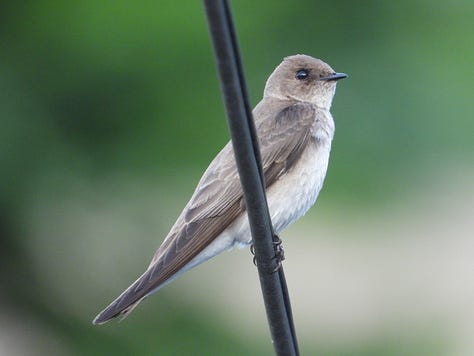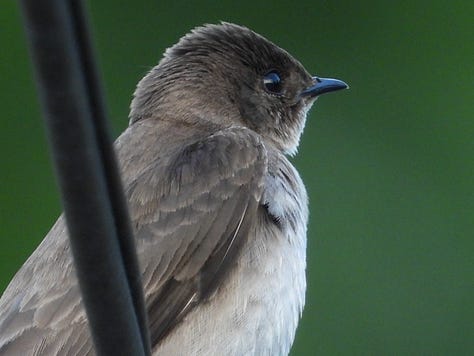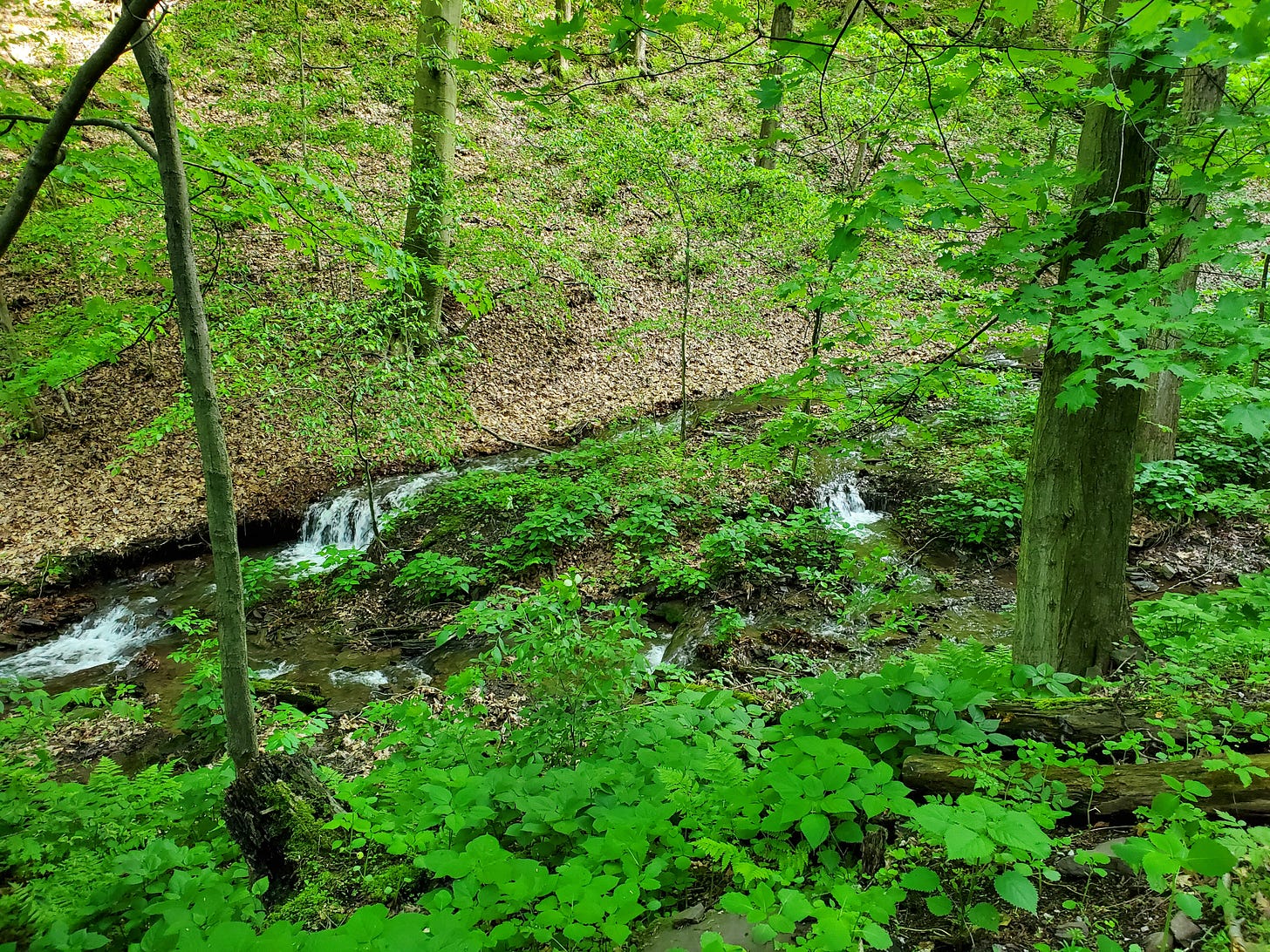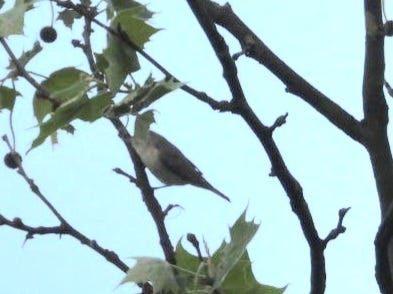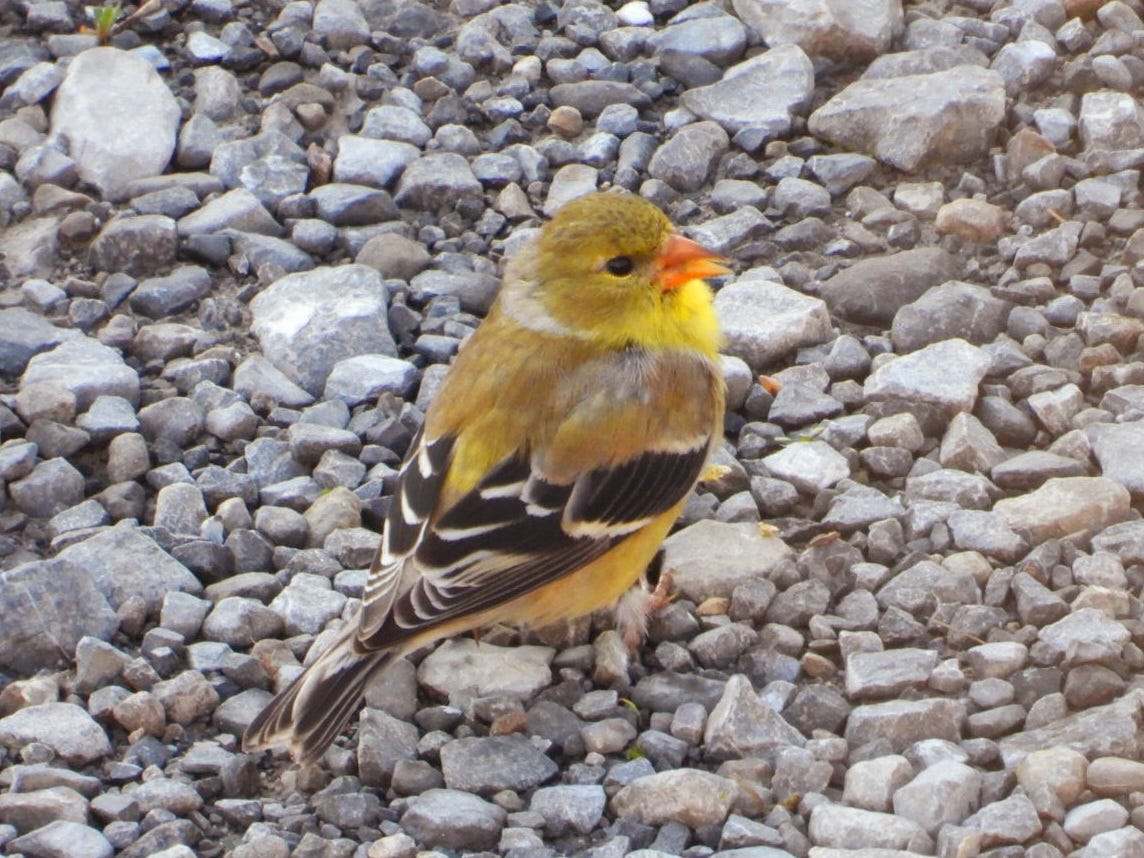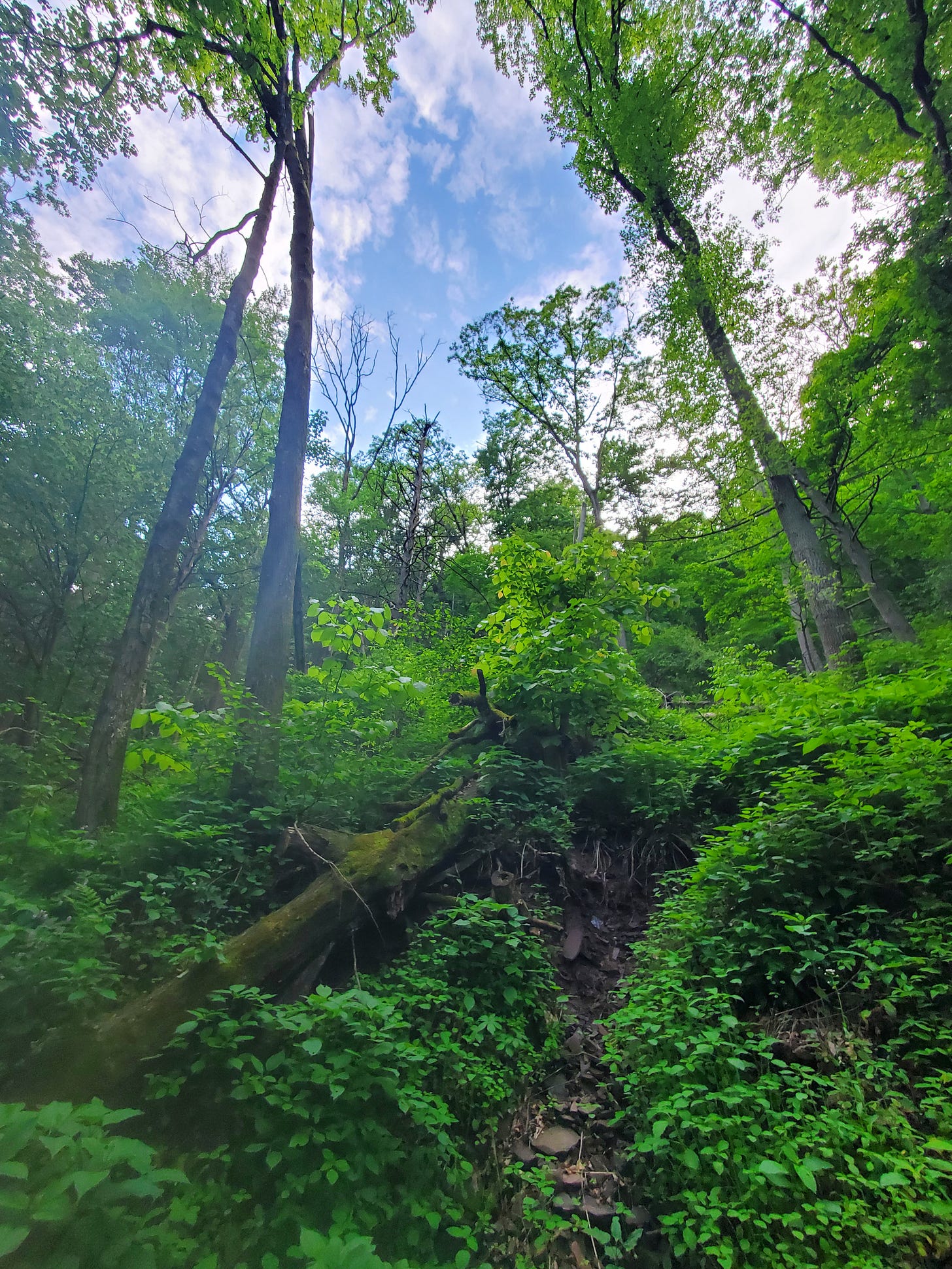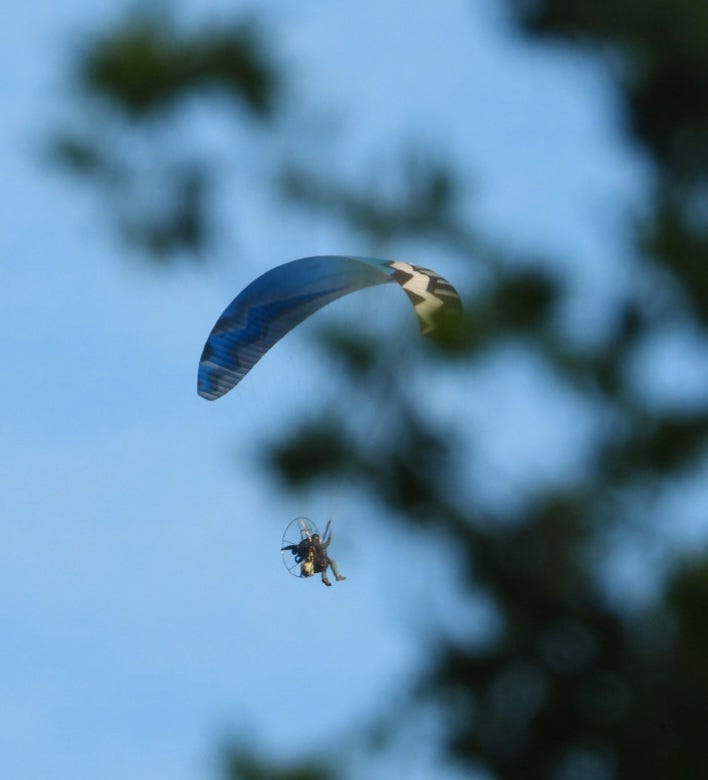Highlights
Alder Flycatcher on NFC, 4:29 AM on Sunday, #185 for 2024
Yellow-bellied Flycatchers (NFC) on Fri & Sun
American Coot, continuing (Wed)
Yellow-breasted Chat, continuing (all week)
Least Sandpiper, Spotted Sandpiper, Solitary Sandpiper, Semipalmated Plover common night flyovers this year
Log
May 13 (Mon). AM: 43 spp. (balcony, 2 hrs. 30 min.); PM: 54 spp. (5-mi. hike, 2 hrs. 35 min.)
May 15 (Wed). AM: 47 spp. (2.2-mi. hike, 1 hr. 45 min.)
May 16 (Thurs). AM: 53 spp. (2-mi. hike, 1 hr. 30 min.); PM: 29 spp. (balcony, 1 hr. 50 min.)
May 18 (Sat). PM: 64 spp. (2-mi. hike, 1 hr. 30 min.)
May 19 (Sun). AM: 40 spp. (balcony, 1 hr. 15 min.); PM: 24 spp. (balcony, 50 min.)
Monday dawns clear and cold on the balcony—39 and dropping, which I don’t suppose we’ll see again this side of September. Before 5 AM, the local Song Sparrows and American Robins are already singing.
Activity picks up quickly after 5, as a Common Raven honks, and then the easy of a Red-winged Blackbird, an unusual early sound from these parts. Northern Rough-winged Swallows are up and about, prrting in the darkness. Suddenly, a Northern Cardinal sings from over on 10th Street, and another answers from the balcony: they duet back in forth, declaring their territories, as a Rose-breasted Grosbeaks eeps.
Clouds or fog pushes toward town from north and south. By 5:30, the Chipping Sparrow is trilling, then the Baltimore Oriole sings a few snatches and the Warbling Vireo joins in. An out-of-place Grasshopper Sparrow seets overhead, as the temperature drops another degree.
Around 6:30, one Warbling Vireo is scolding something somewhere in the top of the sycamore, while another sings its flat, monotonous song nearby. I snap a typical photo:
A couple minutes later, from out of the scratchy, warbling mess of local American Goldfinches, which can sound a lot like Yellow Warblers, the warbler himself finally breaks forth into its iconic Sweet-sweet-sweet-I’m-so-sweet that’s been missing from the dawn chorus this year.
A goldfinch, plumage on fire, pitters about in the parking lot.
Thankfully, the fog and clouds lose out, and we get an actual sunrise, rare this month, at 7:07 AM. A Tennessee Warbler greets it, singing frenetically. To me, it sounds hurried—transients like this one will be rushing away north quickly this week or slipping through at night, with species richness dropping by 40 or more between last weekend and mid-month.
In the late afternoon, I take a quick walk along the freshly cut trails in the field. It’s windy and in the 70s, but the bugs are already out in droves, courtesy of the constant deluges. As I suspected, not a single definitive transient is detectable; more disturbingly, the Yellow-breasted Chat is nowhere to be heard. Did the mowing drive it off, or did it simply fail to find a mate here and decide to move on?
Coot Continuation
Rain on Tuesday. Jungly green, wet, and slimy on Wednesday, but I manage a walk down the tracks, hearing a Nashville Warbler and a Tennessee Warbler, a remind that migration is still ongoing.
Best of all, I manage to grab a clear recording of a Northern Waterthrush from the riverbank below the tracks. It’s close at hand, though I can’t see it, and it’s some way from the swamp where I heard one the other day. The complex song is somewhere between sweet sweet sweet swee wee wee chew chew chew chew, chWhit chWhit chWhit whit whit whit tcheew, and chit chit chit chit chit weeOoo weeOoo weeOoo chblit, as the species’ vocalizations are described in Birds of the World.
Given the rain, I didn’t bring my camera, but I manage to grab some grainy video of the American Coot, which, surprisingly, has stuck around even though the water is down and it should be able to take off and head on to breeding grounds well northwest of here. It putters around the flood-deposited logs and other debris below the bridge, swimming and then walking along the shore, at time standing still and showing its gigantic feet to me. It appears unconcerned by my presence. I suppose this will be the last I see of this year’s most unusual visitor to the hotspot.
At night, the chat continues his quest, vocalizing nearly constantly for hours on end. A single Least Sandpiper emits its unmistakable breet call as it flies overhead around 10 PM. One has been captured around this time the last few nights, clear and close. Perhaps it’s the same one, lingering in the area, feeding in one wetland during the day and roosting in another.
A bit later, the recorder picks up loud peweeps of Semipalmated Plovers—like the Least Sandpiper, a common species that we have never seen touch down in the hotspot. This group contains at least three birds.
Before midnight, the spectacularly soulful screech of a Ring-billed Gull.
Up in the field after 7:45 AM on Thursday, I’m not aware of any of last night’s activity, but I am pleased to be greeted by the chat once again. A Tennessee Warbler is still singing here, but everything else is a local breeding species, including a Barred Owl in the Grove, which takes off from within a few feet of me. I don’t hear the Sharp-shinned Hawks anymore, but Mom, who comes up here nearly every day, tells me they’re still around. Happily, a Golden-crowned Kinglet pair is once again in residence in the spruces.
Late Friday night, a Yellow-bellied Flycatcher chirps as it flies over, the first time I’ve picked it up via NFC in the springtime.
It’s Saturday evening by the time I can make it up to the field, and once again, the chat is silent. Today, there are no obvious out-of-towners, though no doubt transient thrushes lurk silently, waiting for a few more hours before heading onward. A Field Sparrow pauses for a few seconds on a guy wire near the ground, with a large, yellow caterpillar or the like dangling from its beak. On the way back down, I stop below Dave’s house for a slightly unusual sound. It’s the song of a Chestnut-sided Warbler, coming from the old apple tree. They’re still common on the NFC spectrum, but we never seem to attract any to breed here, so I’m guessing this one won’t stick around.
Back on the balcony, I watch a flock of Common Grackles chase an adult Bald Eagle downriver. I didn’t know eagles went after grackle nestlings, but it doesn’t surprise me. After that, I settle in to watch the nightly robin fights in the parking lot. I notice later that a birder from out of town walked the Hollow today, and he managed to snag a few intriguing species. A Yellow-bellied Sapsucker is surprising: late migrant, I assume, but I have to wonder whether any breed here as well, given how cryptic they can be. Best of all, he sights a Mourning Warbler, and when I guess that he saw it at the entrance to the Hollow, he confirms that it was singing right near the gate. This will likely be the sole non-NFC record of the species this spring.
Early Sunday morning, the NFC recorder picks up a migrating Common Nighthawk, as well as the chirps of two more Yellow-bellied Flycatchers and the loud breer of the season’s first Alder Flycatcher.
During a work-saturated weekend, it’s a balcony morning for some respite. Along with the usual crowd, I get one of the best views I’ve had of a Green Heron, flying out of the Gap, passing to my left maybe 40 feet away and disappearing over downtown. Minutes later, a Great Blue Heron follows, much higher up. I suspect Greenies are nesting at the pond, but I would love to know if their larger cousin has a nest anywhere in the area as well.
In the evening, we watch someone in a seemingly rickety contraption slip in and out of heavy clouds, buffeted by winds, appearing to narrowly miss the comms towers. They cross the Gap and disappear over Plummer’s Hollow.
The week ends on perfect notes, despite the turmoil in the world. The local skies are out of synch indeed with the collective insanity that seeps through my phone. Cedar Waxwings buzz about, more than I can remember seeing in past springtimes. Robins are still the first to rise and the last to bed. One of the two local Northern Rough-winged Swallows perches close, giving Pepe the hairy eyeball.
